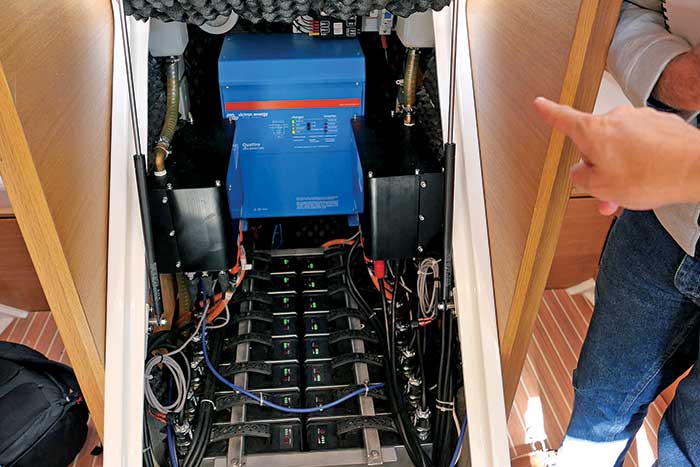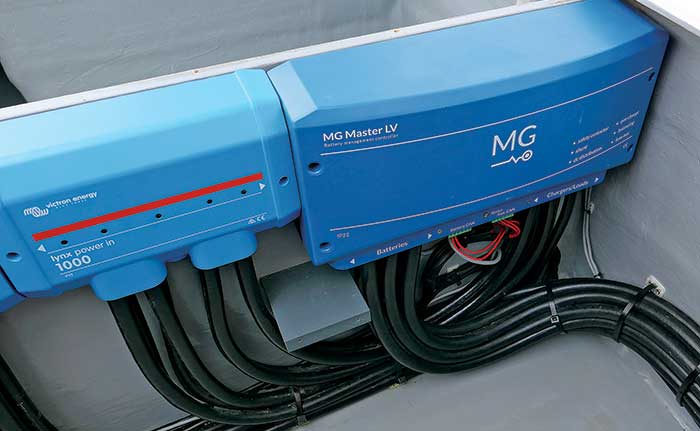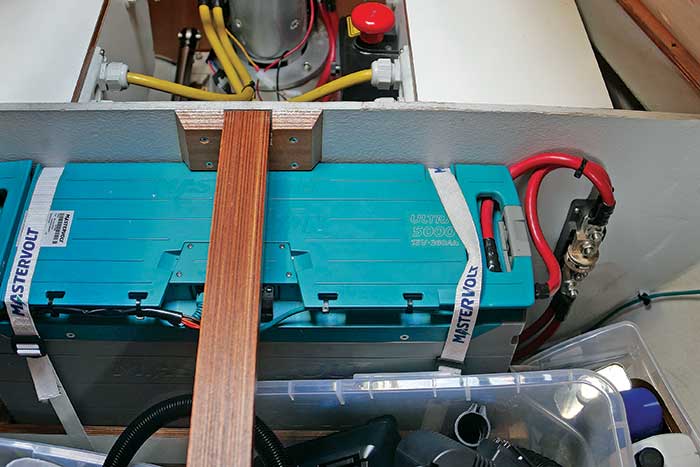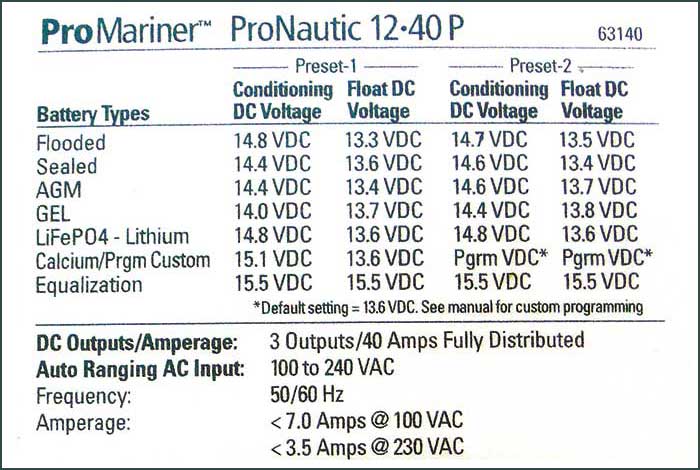Advertisement
The technology has advanced in leaps and bounds. Let's look at where we are, and whether it's ready for prime time.

Large bank of li-ion batteries with a properly programmed charger (blue box) used to supply an e-powered boat using twin Oceanvolt electric drives.
OK, you've seen the ads, watched the YouTube videos, and been to the boat shows to learn everything you could about lithium-ion (li-ion) batteries. You've read boating magazine articles touting the possibility of running your boat without the need for an AC generator because you can add enough battery power to run all of your electrical needs through a DC to AC inverter.
You want to do your part to help reduce carbon emissions by eliminating at least one fossil-fueled engine on board. How is this possible? Well, because li-ion batteries are much lighter than their more traditional counterparts. They can be discharged to much lower levels without damage to the batteries and therefore offer more amps available for a given physical size. Plus, they can be recharged much quicker than traditional lead-acid batteries. One ad even claims that the cycle life of the batteries is as much as 14 times greater than traditional lead-acid batteries. Now you're thinking of pulling the trigger when your batteries need replacing and swapping them out for a new set of li-ion batteries. Before you do, let's take a close look at the state of the art.
A Bit About The Chemistry
Early on there was talk about risk of fire with lithium batteries. I authored a general article several years ago on battery technology, noting that some of the industry's largest retail vendors weren't offering li-ion batteries, despite magazine articles and online forums discussing the pros and cons of the technology. At the time, I was involved with the technical committee working on the development of a standard that would outline basic concerns and precautions necessary to ensure safe li-ion battery installation. In my early article, penned before final recommendations were written, I recommended that AGM lead-acid batteries were the safer bet at that point in time. But a lot has happened in the last several years. This year the American Boat and Yacht Council (ABYC) has a new standard, ABYC E-13, that has allayed most of my concerns over this major technology shift.
A big part of the safety issues here has to do with the exact electrolyte chemistry employed by the battery manufacturers. Lead-acid batteries, first invented in 1859, have always used diluted sulfuric acid as an electrolyte. Regardless of the chemistry, lead-acids incorporate the same basic components internally: cells that have positive and negative electrodes and an electrolyte.
Advertisement
In the case of li-ion batteries, the negative electrode is generally made of carbon. The positive electrode is typically a metal oxide. The electrolyte is a lithium salt mixed in an organic solvent. Over the years, chemists and engineers have experimented with varying materials to maximize electrical current density, and sensitivity to temperature variations. The bottom line has been concern over chemical availability, electrical performance, cost, and safety characteristics. Early on, lithium cobalt oxide was used, then lithium manganese oxide. Most popular today is lithium iron phosphate.
Early lithium cobalt chemistry was quite sensitive to temperature variations and more prone to what is known as "thermal runaway," which you cannot extinguish with a conventional marine-approved fire extinguisher. The only li-ion battery-related fires aboard boats that I'm personally familiar with were using that lithium cobalt chemistry. There are several foreign and domestic fire extinguisher companies that have extinguishers they claim will be effective in the event of a thermal runaway fire, but there are none at this writing that have received U.S. Coast Guard approval. Therefore, the jury is still out on that front.
Consequently, the lithium iron phosphate chemistry has risen to the top as the safest of available chemistries at this writing. I've heard of no fire-related issues with it.
What About Industry Standards?
Multiple industry standards apply to li-ion batteries and their installation. Several look at the actual construction of the batteries. The new ABYC E-13 standard centers around system integration and the actual installation of the battery. Compliance with these standards will go a long way toward ensuring your safety as well as the overall reliability of your battery system. But also, compliance with these standards will add extra costs to the price of the battery itself. (See "Considerations For The Li-ion Consumer" below.)
Considerations For The Li-ion Consumer
- Each battery represents a large collection of individual cells interconnected to create a battery of a given voltage output (e.g., 12, 24, 36, 48 volts). Series connecting li-ion batteries to increase system voltage is NOT generally recommended; this can upset the electronic battery management system's (BMS) logic. That said, Mastervolt, for example, allows for it but limits it. In all cases, following manufacturer recommendations is a must. Paralleling of li-ion batteries is allowed to increase amp-hour capacity, but it will also increase overcurrent protection requirements, adding additional cost.
- Li-ion batteries have a very high recharge acceptance rate. This puts an extreme load on your engine's alternator. Can your existing alternator handle it? If an upgrade is needed to a higher output alternator over 100 amps, a double-belt pulley or serpentine belt conversion will be needed, and this conversion will cost at least $1,000. Check if these components are available for your engine.
- At the very least, a programmable voltage regulator will be needed to accommodate the specific parameters of the li-ion battery.
- You may need a thermal cutout switch for your alternator. High output equates to high heat, which destroys electrical gear over time.
- The battery storage area needs to be watertight.
- Increased alternator output requires upsizing the wiring from your alternator connecting to your electrical system.
- A shore power-supplied battery charger needs to be programmable for li-ion applications. If equipped with a cell-equalization function, it must be shut off and labeled to remain in the off position. Depending on output, new chargers range from about $600 to $2,500, plus installation. Some li-ion battery suppliers dictate that only their charger be used with their batteries.
- Make sure the battery you select has either an internal BMS or matched external system as allowed by ABYC E-13.
- Ensure that the battery storage location can maintain both high- and low-temperature parameters as specified by the battery manufacturer.
- A main battery switch with the appropriate amperage rating is required as an isolation switch, not to be considered as a primary protection device in the output from the li-ion battery or bank. If a shutdown condition is approaching, a BMS should notify the operator with a visual and/or audible alarm prior to disconnecting the battery from the DC system. This involves additional wiring above and beyond the battery installation. Also, not all li-ion BMS systems may offer this function. Confirmation will be needed.
- Engine starting may require a separate traditional lead-acid battery as most li-ion batteries aren't designed with adequate cranking amperage ratings. There are many reports from the field indicating that the li-ion battery's BMS will sense the high starter motor current draw, realize that it's a higher draw than design parameters allow for, and simply shut down the battery. In the case of outboard-powered boats, the alternators and regulation systems are generally not compatible with li-ion recharge needs, so connecting the outboards to lead-acid batteries, then interconnecting li-ion batteries via DC-to-DC converters is a possible option. This will add considerable cost.
- Keep in mind that many outboard engine manufacturers won't honor their warranties if their engines are connected to li-ion batteries. Most recently, we're beginning to see li-ion offerings that do claim to be starter-motor compatible, but cranking amperage ratings for the battery must be matched to the needs of your boat's engine starters.
- Consider providing alternative power to what ABYC describes as "mission critical" systems — navigation lights, electronic positioning, and communication equipment — in the event of a BMS battery shut down. This can be accomplished via an additional li-ion battery or a conventional lead-acid battery. Again, additional wiring may be needed.
- If battery monitoring is something you want, a standard voltmeter won't do the job. Li-ion batteries maintain a constant voltage until they reach the end of their useful state of charge and then drop off to nothing quite rapidly. You'll need a true state of charge (SOC) meter with a shunt that measures amps in and out of the battery to obtain useful readings, which will require wiring.
- ABYC requires all battery outputs to have overcurrent protection in accordance with ABYC E-11. Typically, this means installing a class T fuse and holder, which will cost more than $100.
- Mastervolt, for example, requires that a safety relay (part #770B-BSS) be installed in addition to its MLI series batteries. Look for special requirements for any li-ion battery selected.
- ABYC E-13 dictates that no electrical connections be made directly to the battery that could bypass the BMS. This could happen easily on a system with a remote BMS not integrated into the battery top.
At this writing, ABYC has four relevant standards related to batteries. ABYC Standard A-31, E-10, and E-11 address all battery and charger installations as well as wiring, and the new E-13 specifically addresses li-ion batteries. This new lithium standard is a must-read for anyone considering the jump to li-ion batteries on board.
Additional standards, UN 38.3 and UL 2271, also come into play here as a helpful determinant of lithium-battery and lithium cell-control system integrity for transportation (shipping) purposes. The tests consist of thermal and vibration testing, shock tests, short-circuit testing, impact, and crush testing as well as overcharging and forced discharge tests. UL 2271 covers battery safety requirements for the design, manufacture, and testing of lithium-ion batteries used in Light Electric Vehicle (LEV) applications.

A remotely mounted battery management system (BMS). This is allowed under ABYC standards, however, installers must ensure that nothing is powered directly from the battery(s) before the BMS.

A Mastervolt li-ion battery with integrated BMS and the standards-required class "T" fuse to its right mounted on the bulkhead. This is an additional expense when upgrading to li-ion batteries.
Compliance with these two standards goes a long way toward ensuring a high-quality battery. The RELi-ion brand complies with these standards, and the Dakota and Mastervolt brands comply with the UN 38.3 standard, to name a few. The UN 38.3 standard addresses battery construction issues. Certification to this standard is a huge plus for a battery and its integrated battery management system. ABYC E-13 is more about the installation.
What The Sales Literature May Not Mention
You may have seen ads that imply that a li-ion battery is a "drop-in" replacement. Depending on how your boat is currently equipped, this statement can be far from reality. It's important to remember that the potential economic advantage of this technology really centers around battery cycle life. Without the extremely long cycle life these batteries can offer, the economics don't make sense when compared to, say, a lead-acid AGM-type battery. As a point of comparison, the Dakota brand claims its battery will last four times longer than any lead-acid of comparable size and amp-hour rating; its group 31 size is $900 and comes with an 11-year warranty. A Northstar brand AGM (very high quality) of the same size comes with a four-year warranty and sells for $700. A West Marine brand group 31 flooded cell battery sells for $200 and comes with a one-year replacement warranty.

Label from a Promariner brand battery charger that has a li-ion battery function selection for its output. Most battery chargers do not have this function if they are more than a few years old.
Based on the new E-13 ABYC standard, I've created a checklist of things to consider before you attempt to install li-ion batteries in your boat (see sidebar above). Remember, this list will vary considerably depending on whether you have a sail- or powerboat and how much reserve battery power you want to have.
Final Thoughts
I'm comfortable with li-ion battery technology as long as the standards and guidelines mentioned here are followed. I compare the technology advancement to several things older readers will remember well. ABYC, for instance, was formed in 1954 to deflect the government from regulations on recreational boats. At the time, fires and explosions were occurring at an alarming rate with gasoline-fueled boats. Development of both federal laws and ABYC standards specific to fuel and electrical systems took care of that problem, and you rarely hear of such occurrences today, as long as standards have been followed with installations and maintenance.
In 1975, when electronic ignition systems for engines were introduced, everyone panicked because they wouldn't be able to get their engine running again when the sensitive electronics failed. We went through similar gyrations when electronic fuel injection was introduced, again back to the late 1960s and early '70s. You'd be hard-pressed to find engines today that aren't controlled by electronics, and they're more reliable than ever!
My point is that seemingly delicate electronic systems are actually much more robust than we often give them credit for — as long as you stick to well-known name brands with a track record. The electronic battery management systems (BMS) that control these li-ion batteries today are going to do just fine as long as standards and installation guidelines are followed. If not, then all bets are off.
